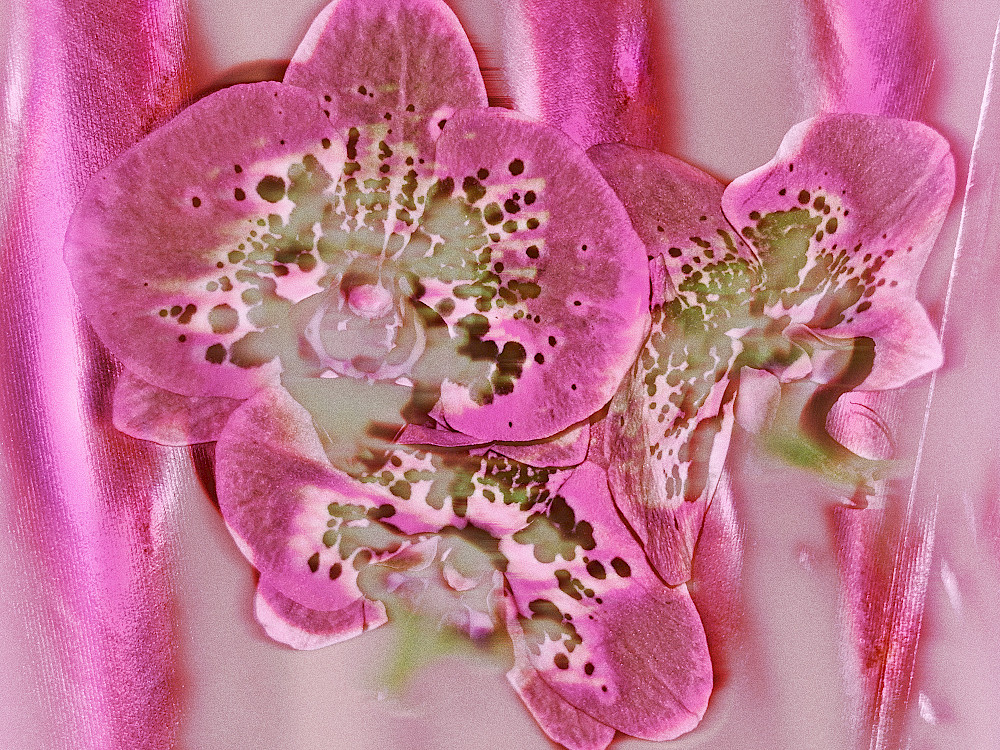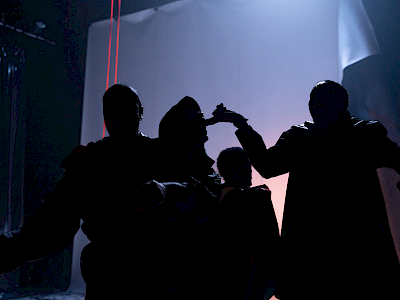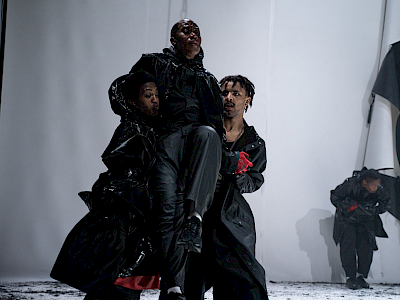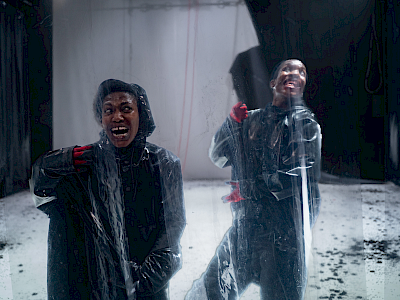22 — 26.05.2025
Cherish Menzo Amsterdam
FRANK
dance — premiere
| ⧖ ±1h30 | €18 / €15 | Contains strobe lighting effects, loud sounds and music and the use of smoke
“We are in an alien world. Only awkward movement is possible.” (Bayo Akomolafe) Choreographer Cherish Menzo examines the figure of the monster in FRANK—short for Frankenstein. More than (re)producing a physical or visual portrayal of the monster, she is researching the monstrous as an embodiment of beliefs and narratives that terrify and horrify, and yet also attract us.
Distortion is a choreographic leitmotif used to generate movement material and as a tool to devour the dance and loosen its structure. Menzo investigates the action of decay and how something gradually breaking down and becoming less or worse can affect one’s gestures. She is joined by Omagbitse Omagbemi, Mulunesh, and Malick Cissé—performing artists from different generations—to construct a performance between the ritual, the apocalypse, and the carnival, where narrated identities are challenged, where flesh can deviate and be corrupted until it bursts and becomes unbearable.
The dancers express their standing in the world with incoherent, broken-down movement in a scenery that collapses around them. In an increasingly unstable world of hiccups and unlikely events, often gruesome and violent, we are reminded of early horror movies and this eerie feeling, the flicker in the dark.
"Menzo is a bold performer, she's got nerve, she's got a very still steeliness about her and she's got important things to say." - Lyndsey Winship, 2022, The Guardian
"Although Menzo’s works are decidedly political, they seem to take a different route to politics than more conventional activist performance. By “stretching the notions of time,” Menzo aims to “generate new readings” for the black body." - Jonas Rutgeerts, 2025, The Drama Review
Matters in monstrosity/Matters of monstrosity
FRANK marks the third chapter of a trilogy of works conceived by choreographer Cherish Menzo between 2019 and 2025. Distortion serves as the trilogy’s leitmotif, first established in Menzo’s solo Jezebel, then in her duet DARKMATTER, and now explored in FRANK, a group piece for four performers. Akin to the “Chopped & Screwed” technique used in hip-hop, distortion has been a method, a tactic even, by which Menzo generates images and movements that defy stereotypical representations of Black bodies. With FRANK, Menzo further develops her study of how such imagery comes to be produced and circulated, turning specifically to the figure of the monster. The trilogy exhibits Menzo’s keen attention to how perception—both visual and somatic—is
informed and therefore can be deformed, so as to see and feel otherwise.
Philosopher Báyò Akómoláfé (1) states “Blackness is indefinitely associated with monstrosity”. Indeed, the monster’s racial genealogy has been penned by white modernity. However, the monster, argues Akómoláfé, is not “a what”—the stable image of inherent evil. Rather, the monster “is a how”: it is “the program lurking in the image, the anamorphosis of the casual image” (2). The monster is a “multicultural technology” (3), operating as a critique of subjectivity that aims to keep identities static and standardized in accordance with the so-
called “natural” order. Therefore, the monster is indeed a disruption, a glitch, that does not seek to destroy, as the trope would have it, but to transform through trickery, surprise, and deception. The monster is an agent of distortion.
In a sense, FRANK stages distortion at work, and the performers—Menzo, joined by Omagbitse Omagbemi, Mulunesh, and Malick Cissé—are its agents. In keeping with Akómoláfé’s philosophy, these agents are not representations of monsters on stage, nor do they perform monstrosity as one might expect from a piece bearing a title that suggests an abbreviation of Mary Shelley’s Frankenstein, or the Modern Prometheus (1818). Clad in black raincoats, hoods drawn overhead, these agents are endowed with a mission which they state from the onset: “Tonight’s performance takes us backstage to witness firsthand the creation, start to finish, of a concoction of imaginations mounted on the frightening. FRANK does not exist. It is imaginary, a stitched fabulation, created, expressly for a particular moment in time.” These anonymous agents, narrators of sorts, thereby draw us into the inner workings of horror, as always already adjacent to desire.
Indeed, staying with this relationship between horror and attraction, FRANK takes its cue from the contributions of another seminal author, Christina Sharpe. Concerned with how monstrosity structures terms of relation, Sharpe names “monstrous intimacies” the enduring, deeply entangled relationships produced by the racial and sexual violence of slavery. However, Sharpe insists that these intimacies are not just historical but are reenacted, transmitted, and experienced in the present, often in ways that are unacknowledge —“everyday mundane horrors” (4) —or that are misidentified as normal or even pleasurable. Menzo, like Sharpe, examines the consequences of denying our shared complicity in how the past continues to shape contemporary narratives and experiences.
FRANK’s thrust stage configuration participates in Menzo’s attempt to question this complicity in a theatrical context, notably through the “monstrous intimacy” formed and sustained by the gaze. As is the case in her two previous pieces, Menzo does not seek to abstract the performance context, nor its performativity in her work. On the contrary, Western theatre has been a site of reproduction and exacerbation of the imagery Menzo specifically takes up in her pieces. As such, FRANK breaks with the frontal set-up of both Jezebel and DARKMATTER, to tighten the focus between performers and audience members, as well as that between audience members themselves who can, in this spatial configuration, watch each other watching. While also referencing the structure of anatomical theatre, the choreographer’s choice of staging throws into doubt who is under actual examination.
Menzo stresses this ambivalence upon which monstrous intimacies have been built, through the use of a transparent plastic curtain that puts it plainly: our gaze is effectively mediated through artificial means. “FRANK does not exist”: layered, we can now unpack the meaning of this statement. The ultimate fabulation/fabrication is convincing ourselves of the infallibility of transparency, of the impermeability of objectivity. Furthermore, while the curtain delineates the tri-frontal configuration of the performance, it establishes a border between the agents, who move both inside and outside of this space, and the audience members, who seemingly stay put. Yet, referring once again to Akómoláfé, we might understand the use of this apparatus differently. “Every time we meet a monster we cross a threshold. We ‘enter into’ a liminal zone” (5), submits Akómoláfé.
Menzo’s staging thus emphasizes how monstrosity thwarts and warps perception: if, as the agents state from the start, FRANK takes place “backstage”, foregrounded by the curtain as the performance space, drawing a thrust configuration that specifically retains the utility of the backstage area, then where are we? Implicated by the tri-frontal set-up, that recalls the complicity of our gaze, we are further positioned in an imbricated space. According to Menzo, this threshold is meant to reflect the “Baka Gorong”, a place located at the back of plantations and in front of the wetlands, where enslaved people in Suriname secretly went to carry out Winti rituals—demonized under Dutch colonial rule—and to consider fleeing. Surinamese singer Anne Goedhart’s piece, Aisa De Na Baka Gorong/So Wadyo/Pityin Begi Mama looped in the performance further suggests this
in-between site of hidden practice and plotting, while also invoking Baka Gorong Aisa’s presence. Monsters emerge when “edges stray” (6), states Akómoláfé: the Baka Gorong is where the borders between place and presence collapse. The song is a harbinger of what’s to come.
Borrowing from Winti footwork, the agents’ initial directive and individual movements soon morph into circular patterns. Here, Menzo makes use of the curtain’s tri-frontal envelope behind which a parade takes shape.
The choreographer references figures such as the “Jab”, derived from “the devil” in French Creole, and used by white colonizers to name enslaved people in Grenada. In an act of derision, masqueraders, covered in molasses, tar, oil, black paint or charcoal, “play the devil” during Caribbean carnival celebrations to satirize the horrors inflicted upon their ancestors. Rather than satisfying the desire for monstrous representations, Menzo choreographs a parade that demonstrates the distortion that occurs when dancing on the threshold from which monsters emerge. The agents’ gestures seem fragmented, yet connected: as they come into contact, they transmit. Movements are borrowed and sampled, corrupted and devoured, made awkward and incomplete. The parade leans into codes of the grotesque, of foolery, or even of the absurd, without ever yielding to them. Upon crossing the threshold, pursues Akómoláfé, “We never walk away intact.” (7) Contagion leads to re-compositions.
Indeed, as the parade thrusts the performance into a decelerated rhythm, during which the performers strip each other of their uniforms, I am reminded, via Joshua Chambers-Letson, of Nina Simone’s use of “the seemingly chaotic metaphor of a ‘great storm’, emphasizing the creative capacities of [...] disordering and reorganization” (8). The metaphor serves to describe how Simone assimilated, and effectively reconfigured, classical music into her repertoire. Re-compositions lead to collapse.
Collapse in FRANK, first announced through song, ultimately becomes material. As previously explored in DARKMATTER and now amplified in this third chapter, FRANK undoes (the) theatre: not only our expectations and modes of perception, but its very structure. The final scenes of FRANK highlight the industrious labor of distortion. A threshold, like a storm, does not leave intact. Though shredded and decayed, the stage is not left bare. It bears the mark of how monstrous intimacies (come to) matter, and exposes why it matters to understand their make.
- Madeleine Planeix-Crocker, April 2025
Madeleine Planeix-Crocker is Curator of Performance and Live Arts at Lafayette Anticipations. Since 2021, she is professor of art theory at the Beaux-Arts de Paris.
(1) Akómoláfé, Báyò. “Black lives matter, But to whom? Why We Need a Politics of Exile in a Time of Troubling
Stuckness (Part II).” Democracy & Belonging Forum, 19 Jan. 2023, www.democracyandbelongingforum.org/
forum-blog/black-lives-matter-but-to-whom-part-2. Accessed 15 April 2025.
(2) Ibid.
(3) Ibid.
(4) Sharpe, Christina. Monstrous Intimacies: Making Post-slavery Subjects. Durham, NC: Duke University Press, 2010, p. 3.
(5) Akómoláfé, Báyò. “Killing Harambe, or how monsters are made”, www.bayoakomolafe.net/post/killing-harambe-or-how-monsters-are-made. Accessed 15 April 2025.
(6) Akómoláfé, Báyò. “Release the Kraken! Why we need monsters in these times of crises”, www.bayoakomolafe.net/post/release-the-kraken-why-we-need-monsters-in-these-times-of-crises. Accessed 15 April 2025.
(7) Akómoláfé, Báyò. “Killing Harambe, or how monsters are made”.
(8) Chambers-Letson, Joshua. After the Party: A Manifesto for Queer of Color Life. New York City, NY: NYU Press, 2018, p. 52.
Presentation: Kunstenfestivaldesarts, KVS
Production: GRIP & Theater Utrecht icw Dance On Ensemble
Concept and direction: Cherish Menzo | Creation and performance: Malick Cissé, Mulunesh, Omagbitse Omagbemi | Sound design: Maria Muehombo aka M I M I | Video design: Andrea Casetti | Sound and video engineering: Arthur De Vuyst | Set design: Morgana Machado Marques | Lighting design: Ryoya Fudetani | Dramaturgy: Johanne Affricot, Renée Copraij | Costumes : Cherish Menzo | Text: Khadija El Kharraz Alami, Cherish Menzo | Artistic advice: Khadija El Kharraz Alami, Nicole Geertruida | Surtitles: Jennifer Piasecki | Technicians on tour: Pieter-Jan Buelens, Arthur De Vuyst, Ryoya Fudetani, Hadrien Jeangette | Graphic design: Nick Mattan | Thanks to: Mildred Caprino, Anne Goedhart, Rodney Frederik & Winti Formation “Krin Ati,” Daryll Geldrop, Ernie Wolf, Sandra Menzo, Shavelie Menzo, Madeleine Planeix-Crocker, Sarah Garnaud, Alice Bröker, Johanna Cool | Texts: Cherish Menzo, Disembodied Narrator, inspired by and with fragments of the introduction text of The Host in Wes Andersons Astroid City and George Orwells, 1984; Fragments, alterations, and reinterpretations of chapter 4 van Mary Shelley, The Modern Prometheus; Cherish Menzo, THE WITNESS, THE MONSTROUS; Chaka Demus and Pliers, Sister Nancy, Toots & the Maytals, Bam Bam | Inspiration, references, bibliography: ‘Baka Gorong’ a place at the back of the former plantations and in front of the swamps (wetlands) where the enslaved in Suriname secretly went to perform their rituals and to consider fleeing ; ‘Jab Jab from Grenada’: the word ‘Jab’ was derived from the French word ‘Diable’ meaning ‘devil’, so a masquerader playing Jab Jab is playing the devil. Jab is a satirical representation of the evil inflicted by the white colonialist on the enslaved | Frantz Fanon, Black Skin, White Masks; Grada Kilomba, Plantation Memories, Episodes Of Everyday Racism; Julia Jristeva, Powers of Horror: An Essay on Abjection; Mary Shelley, Frankenstein; or, The Modern Prometheus; Christina Sharpe, Monstrous Intimacies; Saidiya Hartman, Venus in Two Acts; Susan Stryker, My Words to Victor Frankenstein above the Village of Chamounix Performing Transgender Rage; For the Wild: Dr Bayo Akomolafe on Coming alive to other senses /300 (podcast) ; AS TEMPERATURES RISE, EP 9. Bayo Akomolafe: Monsters, Fugitivity and Sitting in the Lostness of Things (podcast) ; Peter Hutchings, The Horror Film ; Wes Anderson, Asteroid City (The Host and General Gibson) ; Allan Lloyd Smith, This Thing of Darkness’ Racial Discourse in Mary Shelley’s Frankenstein
Production: GRIP & Theater Utrecht (Dagmar Bokma, Anne Breure, Maartje de Groot, Teun de Loos, Philip den Uyl, Hanne Doms, Seline Gosling, Anneleen Hermans, Tom Hemmer, Leonie Jekel, Myrthe Ligtenberg, Thomas Lloyd, Rudi Meulemans, Lize Meynaerts, Klaartje Oerlemans, Jennifer Piasecki, Florien Smits, Sylvie Svanberg, Bregt van Deursen, Ad van Mierlo, Yoni Vermeire, Nele Verreyken Vincent Wijlhuizen) | In collaboration with: Dance On Ensemble / Bureau Ritter | International distribution: A propic - Line Rousseau, Marion Gauvent | Coproduction: Kunstenfestivaldesarts, Carreau du Temple, Productiehuis Theater Rotterdam, Julidans, PACT Zollverein, Montpellier Danse, Centre Chorégraphique National d’Orléans, Tanzquartier Wien, DDD - Festival Dias da Dança, Festival d’Automne à Paris, One Dance Festival, Perpodium
With the support of the Ammodo Foundation, the Government of Flanders, the Tax Shelter of the Belgian Federal Government via Cronos Invest, BNG Bank Theaterprijs and the Cultuurfonds Talentprijs Charlotte Köhler, Culture Moves Europe | Thanks to the Centre national de la danse, BRONKS, KWP Kunstenwerkplaats, Atelier de Paris





